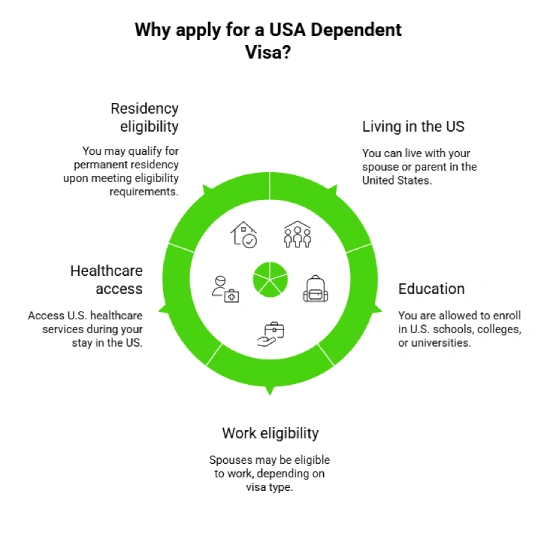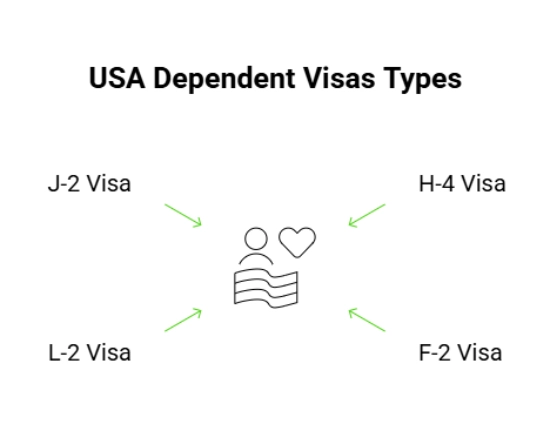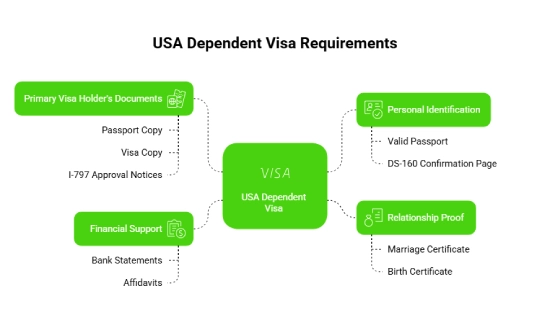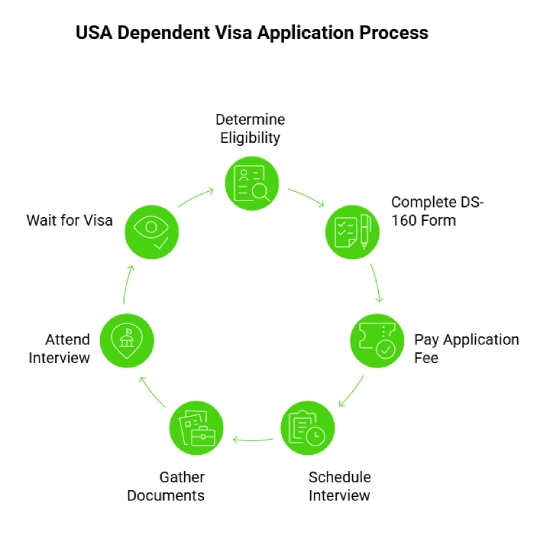A USA Dependent Visa allows spouses and children of individuals working, studying, or residing in the United States to legally join them. The dependent visas are designed to support family reunification, offering dependents the ability to stay in the U.S. for the same duration as the primary visa holder. Depending on the visa type, spouses and children may also gain access to education, healthcare, and limited work rights.

A USA Dependent Visa permits immediate family members, such as, spouses and unmarried children under 21, to join a primary visa holder in the United States. The dependent visa category corresponds to the primary visa type, such as H-1B, F-1, L-1, or J-1. While dependents can reside in the U.S., their rights to work or study vary based on the specific visa classification.
*Want to apply for a US Dependent visa? Sign up with Y-Axis to assist you with the process.

The table below has a complete overview of the most common US Dependent visas:
| Visa Type | Who is it for? | Eligibility | Work Authorization | Study Rights |
| H-4 Visa | For dependents of H-1B skilled workers | Spouse or children (under 21) of H-1B visa holders | Only spouses can apply for EAD (if H-1B holder meets specific conditions) | Full-time or part-time study allowed |
| F-2 Visa | For dependents of F-1 international students | Spouse or children (under 21) of F-1 visa holders | Not permitted | Children may study; spouses can take part-time/recreational courses only |
| L-2 Visa | For dependents of L-1 intracompany transferees | Spouse or children (under 21) of L-1 visa holders | Spouses are eligible to work without needing EAD (automatic under new rule) | Full study permitted |
| J-2 Visa | For dependents of J-1 exchange visitors | Spouse or children (under 21) of J-1 visa holders | Spouses may apply for EAD to work | Full-time or part-time study permitted |
The eligibility criteria for a USA Dependent visa may vary depending on the visa type; however, to apply for the visa, you must fulfil the following criteria:
You must meet the following requirements while applying for a USA Dependent visa:

The list of documents required for a USA Dependent visa are as follows:
You can follow the steps given below to apply for a USA Dependent visa:
Step 1: Determine Eligibility and Visa Type
Confirm you are eligible as a dependent (spouse or unmarried child under 21) of a valid U.S. visa holder (e.g., H-1B, F-1, L-1, J-1).
Step 2: Complete the DS-160 Form
Fill out the DS-160 online non-immigrant visa application form for each dependent and save the confirmation page.
Step 3: Pay the Visa Application Fee
Pay the non-refundable visa application fee (usually USD $185) and retain the receipt.
Step 4: Schedule a Visa Interview
Book an appointment at the nearest U.S. Embassy or Consulate in Canada using the DS-160 confirmation number.
Step 5: Gather Required Documents
Collect all necessary documents, including passport, photograph, relationship proof, and the primary visa holder’s documentation.
Step 6: Attend the Visa Interview
Visit the U.S. Embassy or Consulate on the scheduled date with all supporting documents and attend the interview.
Step 7: Wait for Processing and Receive Your Visa
After approval, your passport with the visa will be returned to you; processing time varies by visa type and location.

*Looking to migrate to the USA? Let Y-Axis help you with the process.
The table below has details of the US Dependent visa fees:
| Visa Type | Application Fee (USD) |
| H-4 (dependent of H-1B) | $205 |
| F-2 (dependent of F-1 student) | $160 |
| L-2 (dependent of L-1 worker) | $185 |
| J-2 (dependent of J-1 exchange visitor) | $185 |
The table below has details of the USA Dependent visa processing times:
| Visa Type | Average Processing Time |
| H-4 Visa (H-1B dependents) | 2 to 8 months (Form I-539) |
| H-4 Visa (from Canada) | Typically 3–6 weeks |
| F-2 Visa (F-1 student dependents) | 2–6 weeks |
| L-2 Visa (L-1 dependents) | 2–4 weeks |
| J-2 Visa (J-1 exchange visitor dependents) | 2–5 weeks |
Yes, Canadian Permanent Residents (PRs) can apply for a USA Dependent Visa. The application process involves submitting the DS-160 form, paying the visa fee, scheduling and attending a visa interview at a U.S. Embassy or Consulate in Canada, and providing the necessary documentation. It's important to ensure all requirements are met to facilitate a smooth application process.
At Y-Axis, we make your USA Dependent Visa journey easier with end-to-end support:
A U.S. dependent visa allows immediate family members (spouses and unmarried children under 21) to accompany or join a principal visa holder in the United States. These visas are linked to the primary visa category; for example, H-4 for H-1B holders, F-2 for F-1 students, L-2 for L-1 intracompany transferees, and J-2 for J-1 exchange visitors. Dependent visas enable families to stay together during the principal visa holder's authorized period in the U.S.
Yes, eligible family members can accompany or join the principal visa holder in the U.S. through a dependent visa. Dependent visas are available for spouses and unmarried children under 21 of individuals holding specific non-immigrant visas. For example, spouses and children of H-1B visa holders can apply for the H-4 visa, while those of F-1 students can apply for the F-2 visa. Dependent visas allow dependents to reside in the U.S. for the duration of the principal visa holder's authorized stay.
Work authorization for dependents varies by visa category. For example, spouses on an H-4 visa may apply for employment authorization if the H-1B principal has an approved Form I-140 or has extended H-1B status beyond six years. Similarly, J-2 visa holders (dependents of J-1 exchange visitors) can apply for work authorization by submitting Form I-765 to USCIS. However, F-2 visa holders (dependents of F-1 students) are not permitted to work in the U.S.
Spouses on certain dependent visas may be eligible to work in the U.S. For instance, H-4 visa holders can apply for employment authorization if the H-1B principal has an approved immigrant petition (Form I-140) or has extended H-1B status under AC21 provisions. J-2 spouses can also apply for work authorization. However, spouses on F-2 visas are not permitted to work. It's essential to review the specific requirements and apply for employment authorization through USCIS where applicable.
You can follow the below steps to obtain a U.S. dependent visa:
Step 1: Determine your eligibility by confirming your relationship to the principal visa holder (spouse or unmarried child under 21).
Step 2: Complete the DS-160 Form
Step 3: Pay the visa application fee of $185.
Step 4: Schedule a visa interview at the nearest U.S. Embassy or Consulate.
Step 5: Gather the required documents including a valid passport, DS-160 confirmation page, visa fee receipt, photograph, proof of relationship to the principal visa holder, and copies of the principal's visa and approval notices.
Step 6: Attend the Visa Interview and submit the necessary documents
Step 7: Await for visa processing
As of now, there have been no significant changes to the policies governing U.S. dependent visas. However, it's crucial to stay informed through official sources, as immigration policies can evolve. For the most current information, regularly check the U.S. Department of State's website and the U.S. Citizenship and Immigration Services (USCIS) website.
The United States offers different dependent visas, some of which are mentioned below:
Applicants must fulfill these requirements when they apply for a U.S. dependent visa:
The requirements for a U.S. dependent visa include the following conditions:
Note: The requirements a person must meet to qualify for a U.S. dependent visa depend on the specific visa category.
The current non-immigrant visa application fee for all dependent visa categories including H-4, F-2, L-2 and J-2 stands at $185. The non-refundable visa application fee must be paid before scheduling a visa interview. F and J visa categories require a separate SEVIS fee which will be added to the application cost. You need to visit the U.S. Department of State official website to verify the required fees for your specific visa category.